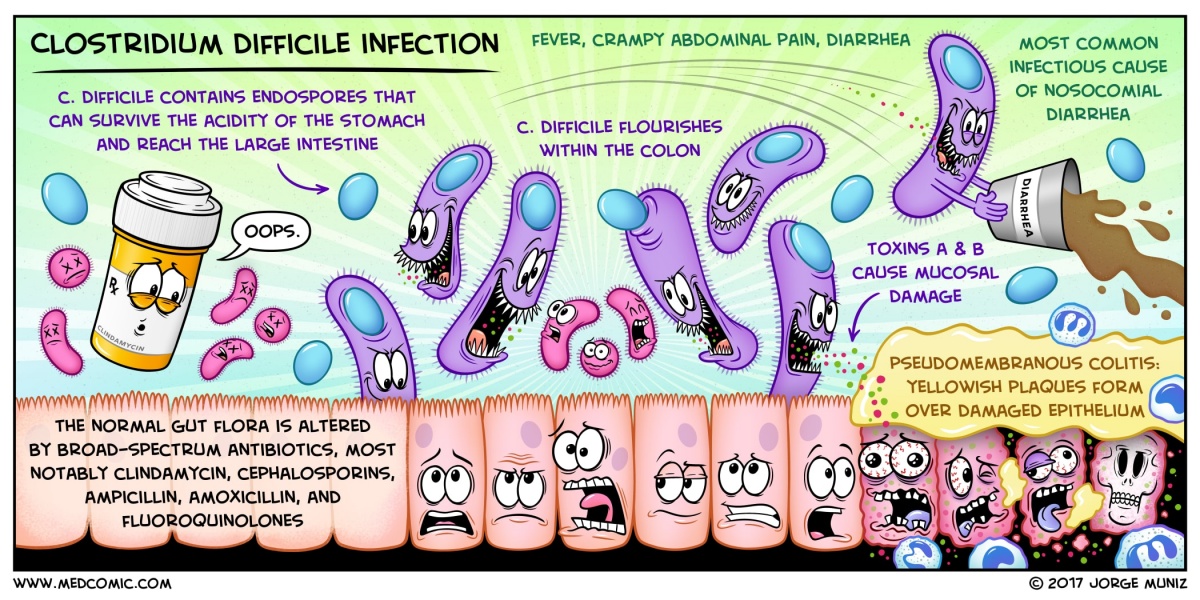An ecological model predicting risk for the development of Clostridium difficile associated diarrhea
This dissertation example is offered for free to help students learn how to writer dissertation on an ecological model predicting risk for the development of Clostridium difficile associated diarrhea. This dissertation example should be used with proper citation and due credit to the original author
Clostridium difficile (C. difficile) is a gram-positive, spore-forming anaerobe, first identified in 1935 in the normal enteric flora of infants (Hall & O’Toole, 1935). A caseseries analysis published in the early 1960’s discounted a serious health threat from C. difficile, concluding that either the toxin was not produced within the human body or that humans did not exhibit a marked sensitivity to the toxins produced by the bacteria (Smith & King, 1962). However, discovery of a link between antibiotic-associated pseudomembranous colitis and a toxin-producing strain of a Clostridium species in the 1970’s clearly established the organism as a human pathogen and triggered a series of investigations associating various antibiotics with the development of the disease (Bartlett, 2004).
 By 1980, C. difficile- associated diarrhea (CDAD) was identified as a serious nosocomial infection (Mulligan, George, Rolfe, & Finegold, 1980; Peikin, Galdibini, & Bartlett, 1980). Since the 1980’s, research has expanded understanding that C. difficile infection occurs in a continuum extending from asymptomatic carriage to fulminating pseudomembranous colitis. Toxigenic strains of C. difficile have been isolated from feces of healthy adults not recently exposed to antibiotics, with reported prevalence ranging from 4.2% to 53.3% (Iizuka et al., 2004; Kato et al., 2001; Nakamura et al., 1981), indicating that transmission and carriage of the organism may occur undetected among the general population, as well as among institutionalized individuals. Although such colonization is believed to be transient in most cases, there is evidence that persistent C. difficile colonization does occur in some individuals (Ozaki et al., 2003). Among hospital patients, colonization followed by an IgG antibody response has been associated with a decreased risk of CDAD acquisition after adjustment for age, sex and disease severity (Kyne, Warny, Qamar & Kelly, 2000), and an acquired immune response to toxin A following an episode of CDAD is believed to be protective against recurrence of diarrhea (Kyne, Warny, Qamar & Kelly, 2001).
By 1980, C. difficile- associated diarrhea (CDAD) was identified as a serious nosocomial infection (Mulligan, George, Rolfe, & Finegold, 1980; Peikin, Galdibini, & Bartlett, 1980). Since the 1980’s, research has expanded understanding that C. difficile infection occurs in a continuum extending from asymptomatic carriage to fulminating pseudomembranous colitis. Toxigenic strains of C. difficile have been isolated from feces of healthy adults not recently exposed to antibiotics, with reported prevalence ranging from 4.2% to 53.3% (Iizuka et al., 2004; Kato et al., 2001; Nakamura et al., 1981), indicating that transmission and carriage of the organism may occur undetected among the general population, as well as among institutionalized individuals. Although such colonization is believed to be transient in most cases, there is evidence that persistent C. difficile colonization does occur in some individuals (Ozaki et al., 2003). Among hospital patients, colonization followed by an IgG antibody response has been associated with a decreased risk of CDAD acquisition after adjustment for age, sex and disease severity (Kyne, Warny, Qamar & Kelly, 2000), and an acquired immune response to toxin A following an episode of CDAD is believed to be protective against recurrence of diarrhea (Kyne, Warny, Qamar & Kelly, 2001).
Clostridium difficile is an anaerobic, spore-forming and gram-positive bacterium that exists in a variety of environments including air, water, soil and animal and human feces. About 3% of healthy individuals may naturally have C. difficile present in their gut, whereas others pick up the bacteria from the environment, primarily in hospital settings. Asymptomatic colonization with C. difficile is seen in approximately 1-5% of community dwelling adults and in 10-25% of hospitalized adults. These bacteria usually do not pose any major health risks until a person is exposed to excessive antibiotics that result in disruption of the normal intestinal flora; which can lead to an abnormal increase in the C. difficile bacteria count in the intestine.
Clostridium difficile infection is one of the major causes of antibiotic associated diarrhea (AAD) and colitis in the United States (US) and accounts for almost all cases of pseudomembranous colitis (PMC) and also 15-25% of all episodes of AAD. It results in approximately 300,000 – 3 million cases presenting with diarrhea and colitis every year in US with the case–mortality rate of 1-2.5%. The number of C. difficile infections has increased in recent years and the mortality rate due to C. difficile associated disease (CDAD) ranges from 6% in patients who have diarrhea to approximately 30% in patients who develop pseudomembranous colitis. Prior studies have also highlighted the fact that CDAD is associated with increased mortality, increased length of hospital stay and increased healthcare costs compared to patients without CDAD. A conservative estimate for the financial impact of CDAD on the US healthcare system has been estimated to be about $1.1 billion per year.
Problem Statement
Through previous research, a number of ecological risk factors pertinent to hospitalized adults have been identified for the development of CDAD. These risk factors include advanced age, use of tube feeding, malnutrition, severity of illness, and the use of medications that alter the intestinal flora, including gastric acid suppressant agents, antibiotics, and cathartics.
Aims and Objectives
The purpose of this study was to develop and test an ecological model useful to nurses in predicting risk for the development of Clostridium difficile-associated diarrhea. It was anticipated that the model would serve three purposes:
- serve as a foundation for development of a valid and reliable risk assessment tool
- aid in the design of future clinical trials of nurse-directed prevention strategies and
- assist clinicians in modifying infection control practices in institutional settings when caring for high-risk individuals.
Significance to Nursing
Nurses spend the most time in the physical proximity of infected and potentially vulnerable patients within the health care system. Because nursing role functions include assistance with toileting, they are often able to predict a positive Clostridium difficile cytotoxin test result based upon knowledge of a patient’s prior antibiotic use and the presence of a distinctive fecal odor (Johansen, Vasishta, Edison, & Hosein, 2002).
Nurses have been implicated as possible agents in the spread of the disease in hospitals (Chang & Nelson, 2000; Perry, Marshall, & Jones, 2001), and are responsible in institutional settings for supervising the environmental decontamination of individual patient rooms and geographic units, critical to the prevention of disease transmission (Chang & Nelson, 2000; Kroker, Bower, & Azadian, 2001; Mayfield, Leet, Miller, & Mundy, 2000; Verity, Wilcox, Fawley, & Parnell, 2001; Wilcox et al., 2003).
Traditional methods of preventing the spread of infectious diseases within hospitals have not proven sufficient to combat emerging infections such as CDAD. An alternative ecological approach to disease prevention requires change in nursing practice to decrease the impact of the organism upon human hosts. By strengthening the natural flora of the hospitalized individual and increasing the spatial and temporal distance between susceptible persons and potentially infectious organisms, the degree of harm caused by the organism can be reduced (Purssell, 2005a).
References
Bartlett, J. G. (2004). COMMENTARY: Bartlett JG, Onderdonk AB, Cisneros RL, Kasper DL. Clindamycin-associated colitis due to a toxin-producing species of Clostridium in Hamsters. J Infect Dis 1977; 136:701. Journal of Infectious Diseases, 190, 202-204.
Chang, V., & Nelson, K. (2000). The role of physical proximity in nosocomial diarrhea. Clinical Infectious Diseases, 31, 717-722.
Hall, I., & O’Toole, E. (1935). Intestinal flora in newborn infants with a description of a new pathogenic anaerobe, Bacillus difficilis. American Journal of Disease in Children, 49, 390-402.
Iizuka, M., Konno, S., Itou, H., Chihara, J., Toyoshima, I., Horie, Y., et al. (2004). Novel evidence suggesting Clostridium difficile is present in human gut microbiota more frequently than previously suspected. Microbiology and Immunology, 48(11), 889-892.
Johansen, A., Vasishta, S., Edison, P., & Hosein, I. (2002). Clostridium difficile associated diarrhoea: how good are nurses at identifying the disease? Age & Ageing, 31(6), 487-488.
Kato, H., Kita, H., Karasawa, T., Maegawa, T., Koino, Y., Takakuwa, H., et al. (2001). Colonisation and transmission of Clostridium difficile in healthy individuals examined by PCR ribotyping and pulsed-field gel electrophoresis. Journal of Medical Microbiology., 50(8), 720-727.
Kroker, P. B., Bower, M., & Azadian, B. (2001). Clostridium difficile infection, hospital geography and time-space clustering. Quarterly Journal of Medicine, 94, 223-225.
Mayfield, J. L., Leet, T., Miller, J., & Mundy, L. M. (2000). Environmental control to reduce transmission of Clostridium difficile. Clinical Infectious Diseases, 31, 995-1000.
Mulligan, M. E., George, W. L., Rolfe, R. D., & Finegold, S. M. (1980). Epidemiological aspects of Clostridium difficile-induced diarrhea and colitis. Am J Clin Nutr, 33(11 Suppl), 2533-2538.
Nakamura, S., Mikawa, M., Nakashio, S., Takabatake, M., Okado, I., Yamakawa, K., et al. (1981). Isolation of Clostridium difficile from the feces and the antibody in sera of young and elderly adults. Microbiology and Immunology, 25(4), 345-351.
Peikin, S. R., Galdibini, J., & Bartlett, J. G. (1980). Role of Clostridium difficile in a case of nonantibiotic-associated pseudomembranous colitis. Gastroenterology, 79(5 Pt 1), 948-951.
Perry, C., Marshall, R., & Jones, E. (2001). Bacterial contamination of uniforms. Journal of Hospital Infection, 48, 238-241.
Purssell, E. (2005a). Evolutionary nursing: the case of infectious diseases. Journal of Advanced Nursing, 49(2), 164-172.
Smith, L. D. S., & King, E. O. (1962). Occurrence of Clostridium Difficile in Infections of Man. Journal of Bacteriology, 84, 65-67.
Verity, P., Wilcox, M. H., Fawley, W., & Parnell, P. (2001). Prospective evaluation of environmental contamination by Clostridium difficile in isolation side rooms. Journal of Hospital Infection, 49, 204-209.
Wilcox, M. H., Fawley, W. N., Wigglesworth, N., Parnell, P., Verity, P., & Freeman, J. (2003). Comparison of the effect of detergent versus hypochlorite cleaning on environmental contamination and incidence of Clostridium difficile infection. Journal of Hospital Infection., 54(2), 109-114.





You must be logged in to post a comment.